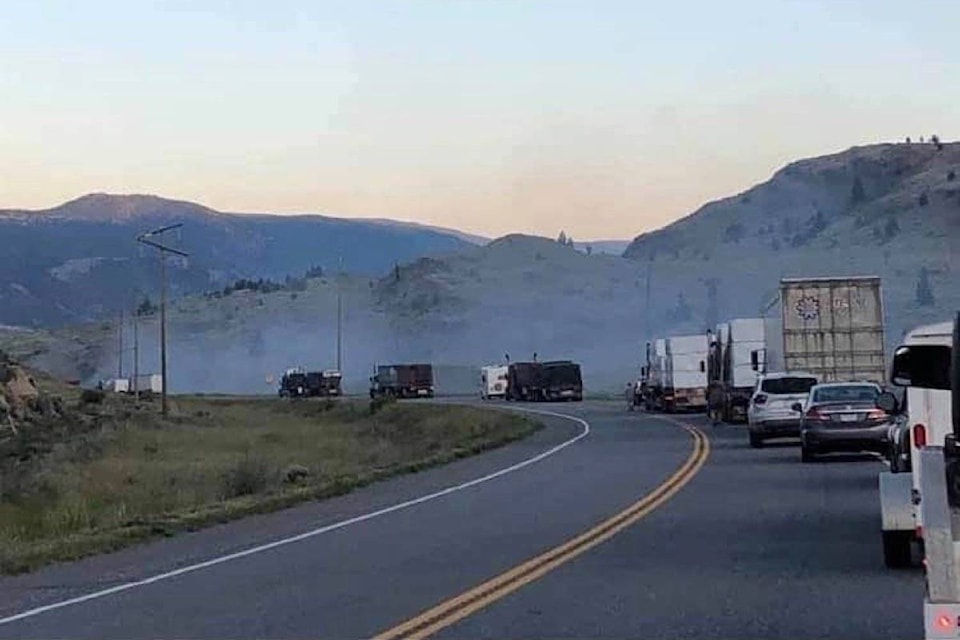On July 27, Ashcroft Fire Rescue responded to two separate incidents, the second of which involved two fatalities, and Ashcroft Fire Chief Josh White says that he is disturbed by the behaviour of many drivers at that scene.
The first incident was a tractor fire just south of Ashcroft at around 4:30 p.m. Early indications are that a piece of farm equipment overheated and caught fire.
“Fortunately it was in the middle of a nice green field, and that worked in our favour, because it just kept [the fire] to the tractor,” says White.
The second call came in just before 7:30 p.m., with the initial report stating that there was a vehicle fire with entrapment just south of the Red Hills rest stop on Highway 1 south of Ashcroft. The highway was closed for almost 24 hours as an investigation and cleanup of the site were ongoing.
“We rolled with the fleet knowing that the grasslands are drying out,” says White of receiving the call. “We knew it was on the edge of our boundary [for coverage], and it ended up being just outside, but it would have burned into our area.
“We knocked down the perimeter of the fire and kept it from migrating further. It could have been really bad.”
The fire had started when a southbound Honda Civic apparently crossed the centre line into the path of a northbound semi, causing a head-on collision that sent the semi off the road, where it caught fire. White says that the initial reports stated that there were four people in the Honda, but it was later confirmed that the lone occupant was the driver, a woman who was apparently from Washington state.
Both the driver of the Honda and the driver of the semi were pronounced dead at the scene of the accident.
White says that anyone arriving at the site of the accident could not have failed to notice there was someone dead at the scene: “It was obvious.” What disturbs him is the number of people who drove through the site in the immediate aftermath of the accident, before first responders arrived and could close the highway.
“We passed 30 to 50 vehicles coming in the opposite direction while we were on our way to the scene,” he says. “There was oil on the ground, so it was clear people had driven through.
“What a lot of people don’t realize is that when there’s an accident involving a fatality it’s a crime scene. When the debris field is disturbed it makes it harder for our friends in the RCMP to conduct their investigation.
“There might be a clue in that debris field to point to who was at fault, and it might be enough to put someone in jail. Someone [who causes injury or death] could get off the hook because the whole crime scene was disturbed.”
White says that anyone arriving at an accident site before first responders get there should pull over in a safe location, put their hazard lights on, and call 9-1-1. “You don’t have the right to stop traffic, but you can talk to anyone else coming up on the scene after you and tell them to stop and turn around. If there’s a fatality the road will be closed for some time. People driving through it just makes it harder for the RCMP to conduct their investigation and holds everyone up longer.”
He acknowledges that people are in a hurry to get where they’re going and don’t appreciate delays, but says that people need to stop, go back, and find an alternative route.
“There are always other ways. Yes, it will add more time to your journey, but at the same time it’s respectful, and it’s not disturbing that crime scene.”
As for people taking pictures of accident scenes, White has one word: “Don’t.”
“If people see a picture of that vehicle on social media that’s with them for the rest of their life. You don’t need these pictures on your phone or on social media. It’s disrespectful.
“People will take pictures of accidents before calling 9-1-1. If people are doing it to get likes on Facebook or Twitter then we’re really disconnected from our humanity. Tragedies like this are best left to professional media going to their sources.”
He adds that he knows going to an accident scene is difficult for a lot of people, and that calling 9-1-1 is enough. “Do what you’re comfortable with. We would never ask for people to go see if someone is alive or dead in a vehicle. Just calling 9-1-1 is a huge step.
“Also, stay there until the police arrive or another first responder shows up. People call and say ‘There’s a car over an embankment,’ but when we arrive there’s no one there and we can’t find the location.”
At the end of the day, he says, doing the right thing and being respectful at an accident scene should take precedence over your journey.
“A person’s well-being is more important than getting to your destination.”
editorial@accjournal.ca
Like us on Facebook and follow us on Twitter
